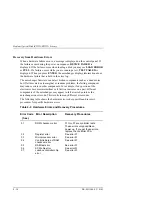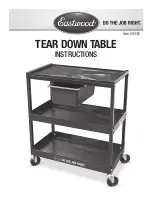
Chapter 4. Troubleshooting and Diagnostics
EK–MOL80–SV. B01
4–25
Table 4–4 Micro-Move IDs
ID (hex.)
Description
1
Move picker transport up. Fast.
2
Move picker transport down. Fast.
3
Move picker transport up slowly, looking for resistance. Used in
vertical find home sequence.
4
Move picker transport down slowly, looking for resistance. Used in
vertical find home sequence.
5
Move a small amount upward, to relieve tension in the servos.
Used after finding "home" in the vertical find home sequence.
6
Make a small vertical movement as a plunge is made into a drive.
Used to "wiggle" the picker during error recovery.
8
Move picker transport up to the top of the jukebox, checking for a
clear path. Used in the vertical find home sequence.
9
Move picker transport to the bottom of the jukebox, checking for
a clear path. Used in the vertical find home sequence.
11
Move slowly up far enough to establish that there is enough
room to flip the picker. Used in the plunge find home sequence.
12
Move slowly down far enough to establish that there is enough
room to flip the picker. Used in the plunge find home sequence.
13
Move slowly to the flip clear area (determined in micro-moves 11
and 12). Used in the plunge find home sequence. Also used in
power fail recovery to move the picker off of a cartridge that may
have been between the picker and the magazines when the
power failed and the picker settled.
14
Move slowly downward to the flip clear area (determined in
micro-moves 11 and 12). Used in the plunge find home
sequence.
15
Move vertically to restore the picker to the position it had before
an error (and error recovery, occurred. Only called in error
recovery.
16
Move up. Used in the motor test during power up.
17
Move down. Used in the motor test during power up.
62
Move slowly to one side of the translate frame. Used to find
translate home during power up. Movements after power up use
the translate home ID, 63.
















































